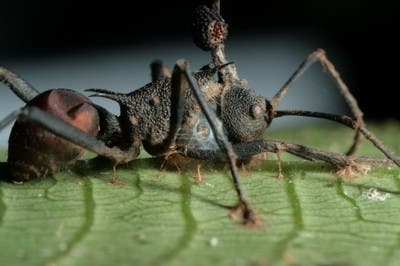Last year, we reported on one of the most gruesome and horrific acts that goes on in nature; it seems so unreal, like if some sort of SciFi monstrous scenario transcended into the realm of reality, that one has a hard time wrapping his head around it. Yes, as some of you might have read previously, I’m talking about the zombie-ant fungus or Ophiocordyceps. These parasite fungi infect tropical ants, literary taking control of their actions, ultimately leading the infected ant to march to its death at a mass grave near the ant colony, where the fungus spores erupt out of the ant’s head so it can spread even further.

In a case where biology is stranger than fiction, the parasite of the zombie-ant fungus is itself a fungus — a hyperparasitic fungus that specializes in attacking the parasite that turns the ants into zombies,” Hughes said. The research will be published in the journal PLoS ONE.
The hyperparasitic fungus effectively castrates the zombie-ant fungus so it cannot spread its spores,” said Hughes, who is an assistant professor of entomology and biology, and a member of the Center for Infectious Disease Dynamics at Penn State. “Because the hyperparasitic fungi prevents the infected zombie-ant fungus from spreading spores, fewer of the ants will become zombies.”
The team of biologists, lead by Hughes, created a detailed model which offered extra insights regarding the fungus-infected ants and the parasite-infected zombie-ant fungus interaction. Previously, scientists had known that ants ward off infections by carefully grooming each other, now the model reveals the effect of ant behavior on limiting infection. Nature often sends in unexpected allies to aid those threatened by atypical enemies.
“Interestingly, beyond the well-known effect of defensive ant behavior, our new research reveals the added effect of the castrating actions of the hyperparasite fungi, which may result in significantly limiting the spread of the zombie-ant fungus,” Hughes said.
The scientists report that only about 6.5 percent of the spore-producing organs of the zombie-ant fungus were viable.
“Even though there are a lot of dead and infected zombie ants in the neighborhood, only a few of the spores of the zombie-ant fungus will become mature and able to infect healthy ants,” Hughes said. “Our research indicates that the danger to the ant colony is much smaller than the high density of zombie-ant cadavers in the graveyard might suggest. This complex interaction between ant colonies, their brain-manipulating parasites, and other fungi capable of lending assistance to the colony underscores the need to study social insects under natural conditions.”
The findings were reported in the journal PLoS ONE.
source: Penn State University






